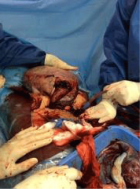Abstract
Research Article
Anal cytology in immunocompetent patients with high-grade intraepithelial neoplasia (CIN II and CIN III)
Marcio Erik Franco Ribeiro*, Lyliana Coutinho Resende Barbosa and Taylor Brandão Schnaider
Published: 13 February, 2020 | Volume 3 - Issue 1 | Pages: 007-012
Introduction: Anal cancer is directly related to the presence of high-grade HPV. Immunocompromised patients have defined conducts, something which is not observed in immunocompetent patients.
Objective: To study the anal cytology of patients with high-grade intraepithelial neoplasia (CINII and III) in order to propose a protocol to be followed by the Oncology Gynaecology Service at the Samuel Libânio Clinical Hospital (HCSL).
Methods: Clinical, prospective, transversal and single-centered study. Sampling was by convenience within one year. A total of 150 patients were studied. Out of these, 76 were patients with high-grade cervical intraepithelial lesions diagnosed through histopathological examination of the uterine cervix (Study Group) and 74 without high-grade intraepithelial lesions and with cervical cytology negative for neoplasia (Control Group). The following variables were analyzed: age, sexarc, tobacco use, alcohol consumption, STD history (not HPV), menopause, Hormone Replacement Therapy, anal sex practice, parity, number of sexual partners and contraceptive use.
Results: There was no significant difference between the number of cases in altered anal cancer oncology in the study group, in comparison with the control group.
Conclusion: There were changes in the anal cytology of the study group and these should be evaluated due to the risk of dealing with pre-neoplastic anal lesion. Clinical Trials: NCT03241680.
Read Full Article HTML DOI: 10.29328/journal.cjog.1001041 Cite this Article Read Full Article PDF
Keywords:
Papillomaviridae; Anus neoplasms; Uterine cervical neoplasms; Cytodiagnosis
References
- Instituto Nacional de Câncer (INCA). Colo do útero. Disponível em: http://www2.inca.gov.br/wps/wcm/connect/tiposdecancer/site/home/colo_utero/definicao. Acesso em 06 mar. 2017.
- Wright J. Cervical intraepithelial neoplasia: treatment and follow-up. UptoDate; 2016. Disponível em.
- Palefsky JM, Cranston RD. Virology of human papillomavirus infections and the link to cancer. 2010.
- Feldman S, Crum CP. Cervical cancer screening tests: techniques for cervical cytology and human papillomavirus testing. 2017.
- Ryan DP, Mamon H. Treatment for potentially resectable exocrine pancreatic cancer. 2017.
- Palefsky JM, Cranston RD. Anal squamous intraepithelial lesions: diagnosis, screening, prevention, and treatment. 2017.
- Leeds IL, Fang SH. Anal cancer and intraepithelial neoplasia screening: a review. World J Gastrointest Surg. 2016; 8: 41–51. PubMed: https://www.ncbi.nlm.nih.gov/pubmed/26843912
- Bosman FT, Carneiro F, Hruban RH, Theise ND. WHO classification of tumours of the digestive system. 4thed. Geneva: WHO; 2010.
- Palefsky JM, Giuliano AR, Goldstone S, Moreira Junior ED, Aranda C, et al. HPV vaccine against anal HPV infection and anal intraepithelial neoplasia. N Engl J Med. 2011; 365: 1576-1585. PubMed: https://www.ncbi.nlm.nih.gov/pubmed/22029979
- Capobiango A, Silva Filho AL, Nunes TA. Diagnóstico de HPV anal em mulheres com NIC: prevenção de câncer do ânus? Rev Bras Coloproctol. 2009; 29: 443-450.
- Heráclio SA, Araujo TA, Souza ASR, Cahen K, Lima Junior SF, et al. Prevalência da lesão HVP induzida em canal anal de mulheres com neoplasia intraepitelial cervical 2 e 3: um estudo de corte transversal. Rev Bras Ginecol Obstet. 2015; 37: 480-485.
- Giraldo P, Jacyntho C, Costa C, Iglesias M, Gondim C, et al. Prevalence of anal squamous intra-epithelial lesion in women presenting genital squamous intra-epithelial lesion. Eur J Obstet Gynecol Reprod Biol. 2009; 142: 73-75. PubMed: https://www.ncbi.nlm.nih.gov/pubmed/19019529
- Park IU, Ogilvie JW, Anderson KE, LI Z, Darrah L, et al. Anal human papillomavirus infection and abnormal anal cytology in women with genital neoplasia. Gynecol Oncol. 2009; 114: 399-403. PubMed: https://www.ncbi.nlm.nih.gov/pubmed/19501896
- Koppe DC, Bandeira CB, Rosa MR, Cambruzzi E, Meurer L, et al. Prevalence of anal intraepithelial neoplasia in women with genital neoplasia. Dis Colon Tectum. 2011; 54: 442-445. PubMed: https://www.ncbi.nlm.nih.gov/pubmed/20733438
- Vasconcelos Filho FE, Eleutério Junio J, Dias BHM, Siulva AMHP, Andrade ACR. Is screening of or anal squamous intraepithelial lesions in women with genital human papillomavirus intraepithelial lesions necessary? DST – J Bras Doenças Sex Transm. 2013; 25: 145-149.
- Dermen KH, Thomas SN. Randomized controlled trial of brief interventions to reduce college students’ drinking and risk sex. Psychol Addict Behav. 2011; 25: 583-594. PubMed: https://www.ncbi.nlm.nih.gov/pubmed/21928866
- Roura E, Castellsagué X, Pawlita M, Travier N, Waterboer T, et al. Smoking as a major risk factor for cervical cancer and pre-cancer: results from EPIC cohort. Int J Cancer. 2014; 135: 453-466. PubMed: https://www.ncbi.nlm.nih.gov/pubmed/24338632
- Bezerra SSJ, Gonçalves PC, Franco ES, Pinheiro AKB. Perfil de mulheres portadoras de lesões cervicais por HPV quanto aos fatores de risco para câncer de colo uterino. DST – J Bras Doenças Sex Trams. 2005; 17: 143-148.
- Carvalho MCMP, Paula CL, Queiroz ABA. Lesões precursosras do câncer cervicouterino associado ao tabagismo: um estudo sobre o conhecimento entre as mulheres que fumam. Revista Brasileira de Cancerologia. 2011; 57: 387-394.
- Fonseca FV, Tomasich FDS, Jung JE. Neoplasa intraepitelial cervical: da etiopatogenia ao desempenho da tecnologia no rastreio e no seguimento. DST – J Bras Doenças Sex Transm. 2012; 24: 53-61.
- Fritsch H, Aigner F, Ludwikowski B, Reinstadler-Zankl S, Illig R, et al. Epithelial and muscular regionalization of the human developing anorectum. Anat Rec (Hoboken). 2007; 290: 1449-1458. PubMed: https://www.ncbi.nlm.nih.gov/pubmed/17853405
- Jacyntho C. HPV X Hormônios: especulações sobre o vírus gerar duas doenças. 2004.
Similar Articles
Recently Viewed
-
ERRATUM to: Fiesta vs. Stress Condition the Incidence and the Age at Menarche. Forty Years of ResearchCarlos Y. Valenzuela*. ERRATUM to: Fiesta vs. Stress Condition the Incidence and the Age at Menarche. Forty Years of Research. Clin J Obstet Gynecol. 2025: doi: 10.29328/journal.cjog.1001190(E); 8:
-
Fiesta vs. Stress Condition the Incidence and the Age at Menarche. Forty Years of ResearchCarlos Y Valenzuela*. Fiesta vs. Stress Condition the Incidence and the Age at Menarche. Forty Years of Research. Clin J Obstet Gynecol. 2025: doi: 10.29328/journal.cjog.1001190; 8: 069-073
-
Obstetric Paradoxes and Didactic Equations: The Impact of Mathematical Teaching on Childbirth and BeyondPascual Chiago*. Obstetric Paradoxes and Didactic Equations: The Impact of Mathematical Teaching on Childbirth and Beyond. Clin J Obstet Gynecol. 2025: doi: 10.29328/journal.cjog.1001197; 8: 096-101
-
Intravenous Leiomyomatosis of the Uterus with Intracardiac ExtensionTomas Reyes-del Castillo*,Minerva I Hernandez-Rejon,Jose L Ruiz-Pier,Mario Peñaloza-Guadarrama,Carlos E Merinos-Avila,Cristina Juarez-Cabrera,Pedro A del Valle-Maldonado,Sofia Ley-Tapia,Valentín Gonzalez-Flores. Intravenous Leiomyomatosis of the Uterus with Intracardiac Extension. Arch Vas Med. 2025: doi: 10.29328/journal.avm.1001021; 9: 003-007
-
Estimation of Radiation Dose to Blood Vessels and Components from Medical Imaging Procedures: Current StatusKhalid M Aloufi*. Estimation of Radiation Dose to Blood Vessels and Components from Medical Imaging Procedures: Current Status. Arch Vas Med. 2025: doi: 10.29328/journal.avm.1001020; 9: 001-002
Most Viewed
-
Feasibility study of magnetic sensing for detecting single-neuron action potentialsDenis Tonini,Kai Wu,Renata Saha,Jian-Ping Wang*. Feasibility study of magnetic sensing for detecting single-neuron action potentials. Ann Biomed Sci Eng. 2022 doi: 10.29328/journal.abse.1001018; 6: 019-029
-
Evaluation of In vitro and Ex vivo Models for Studying the Effectiveness of Vaginal Drug Systems in Controlling Microbe Infections: A Systematic ReviewMohammad Hossein Karami*, Majid Abdouss*, Mandana Karami. Evaluation of In vitro and Ex vivo Models for Studying the Effectiveness of Vaginal Drug Systems in Controlling Microbe Infections: A Systematic Review. Clin J Obstet Gynecol. 2023 doi: 10.29328/journal.cjog.1001151; 6: 201-215
-
Causal Link between Human Blood Metabolites and Asthma: An Investigation Using Mendelian RandomizationYong-Qing Zhu, Xiao-Yan Meng, Jing-Hua Yang*. Causal Link between Human Blood Metabolites and Asthma: An Investigation Using Mendelian Randomization. Arch Asthma Allergy Immunol. 2023 doi: 10.29328/journal.aaai.1001032; 7: 012-022
-
Impact of Latex Sensitization on Asthma and Rhinitis Progression: A Study at Abidjan-Cocody University Hospital - Côte d’Ivoire (Progression of Asthma and Rhinitis related to Latex Sensitization)Dasse Sery Romuald*, KL Siransy, N Koffi, RO Yeboah, EK Nguessan, HA Adou, VP Goran-Kouacou, AU Assi, JY Seri, S Moussa, D Oura, CL Memel, H Koya, E Atoukoula. Impact of Latex Sensitization on Asthma and Rhinitis Progression: A Study at Abidjan-Cocody University Hospital - Côte d’Ivoire (Progression of Asthma and Rhinitis related to Latex Sensitization). Arch Asthma Allergy Immunol. 2024 doi: 10.29328/journal.aaai.1001035; 8: 007-012
-
An algorithm to safely manage oral food challenge in an office-based setting for children with multiple food allergiesNathalie Cottel,Aïcha Dieme,Véronique Orcel,Yannick Chantran,Mélisande Bourgoin-Heck,Jocelyne Just. An algorithm to safely manage oral food challenge in an office-based setting for children with multiple food allergies. Arch Asthma Allergy Immunol. 2021 doi: 10.29328/journal.aaai.1001027; 5: 030-037

If you are already a member of our network and need to keep track of any developments regarding a question you have already submitted, click "take me to my Query."

















































































































































